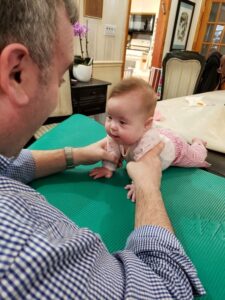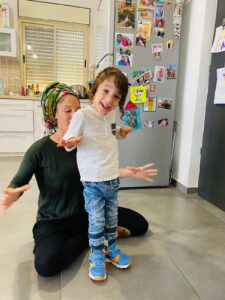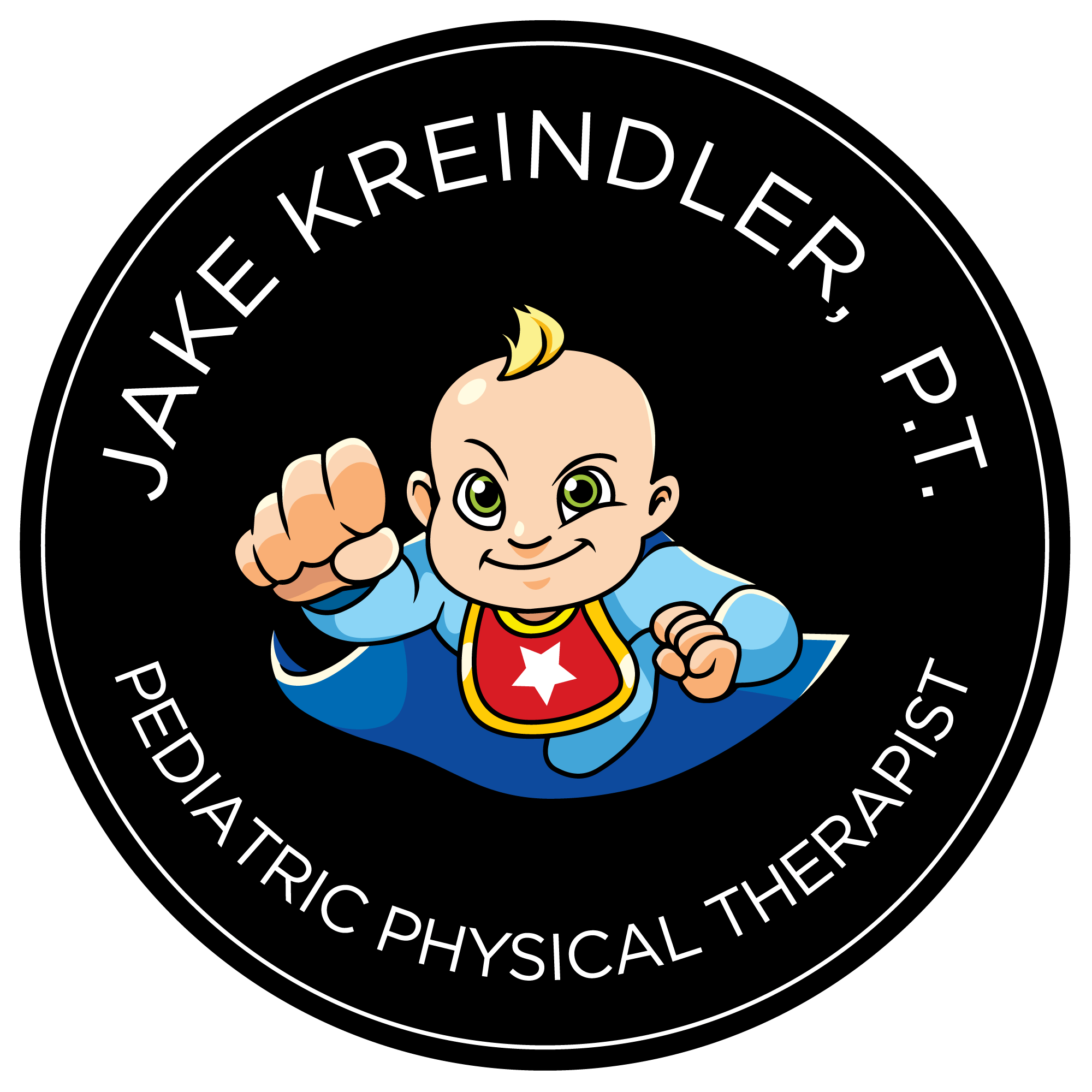When a family finds themselves needing physical therapy for a child with neurological damage or delay, a genetic condition, prematurity, or other conditions with significant risk factors for gross motor delays, they frequently feel scared and overwhelmed. They don’t know what to expect. They need guidance. They may try to reach out to family members or friends but are often disappointed since they don’t have experience with that condition or situation.
So often, families turn to social media to get valuable information and support. This is likely the first time they found someone who can truly relate. Finding someone who has experienced the path they will have to follow is reassuring.
After the diagnosis is processed and the baby comes home safely, the family will work on getting the help they will need. That will usually include therapists who service the early intervention population- Physical, Occupational, Speech and Feeding, Vision, and Special Education.
Pediatric Physical Therapists (PT’s) help children with all diagnoses learn to achieve their full gross motor potential. PT’s are often the first line of defense in helping children at risk for delays.
Parents who have the right mindset when starting therapy, especially the intensive therapy model, will navigate the process more easily, with less emotional upheaval, and with the presence of mind to navigate challenges.
These suggestions are geared to families of children who have been recently diagnosed with any condition that can affect their ability to develop their gross motor skills on time.
To achieve independence in their movements, children need to master many skills. PT’s help children with delays reach these goals.
These skills can include, but are not limited to:
Head control
Trunk control
Army crawling
Transitioning between positions
Crawling
Sitting
Pulling up to standing
Cruising at furniture
Standing alone
Walking
Balancing on all surfaces
Playing ball games
Walking up and down the stairs
Riding a tricycle
Playing on park equipment
Playing with friends
The list goes on and on.
As a PT with 25 years of experience, I have worked with thousands of children and their families.
Many families over the years have shared their joy, tears, frustrations, celebrations, and everything in between. There are several lessons that seem to be the common denominators- the ones that shaped their experiences and mine.
NOTE: These are my observations from my personal and professional experiences. Your values, ideas, and opinions may differ from mine. That is ok. Ultimately, these suggestions are meant to help you. If they don’t, advocate for your child, self, and family by following your heart and taking guidance from those you trust.
Here are 8 things I wish every family understood before starting their therapy journey.
1. Every child is different
We all know that no two people are the same, but sometimes forget that no two children are the same! Two children with the same diagnosis can have vastly different experiences, skill levels, and gross motor function. While you may find some valuable information on online forums, Facebook groups, Instagram accounts, and the like, no one can determine exactly how this condition with affect your child specifically. Keep in mind that while your online search may seem fruitful, nothing replaces the advice of a trained professional.
Furthermore, while certain diagnoses can have similar symptoms, manifestations, and expectations, comparing your child to others is not advised. It will frequently disappoint and frustrate you. The only child yours should be compared to is themselves. Work hard to help your child achieve their best; to reach their full potential. Preconceived ideas may impede that lofty goal.
Here are a few examples.
In the course of my career, I have always felt very connected to the Down Syndrome community. I have worked with many children with Down Syndrome over the years, and in my experience, I noticed some gross motor similarities emerge. (You can read more about that here. https://getyourbabymoving.com/down-syndrome-a-physical-therapy-perspective-aka-the-making-of-a-superbaby/)
Children with Down syndrome typically exhibit gross motor delays in the 50% range. This means that while neurotypical children walk between 12-18 months, children with Down Syndrome usually walk independently between their 2nd and 3rd birthdays, with the average at around 30 months and some children walking even later, depending on several factors. This sometimes can be affected by the frequency or quality of therapy, level of low muscle tone, cardiac complications, or other factors.
These norms also have exceptions. I have worked with many children with Down Syndrome who have walked by 17 or 18 months (which is within the age appropriate range for neurotypical children), and many more before their 2nd birthday. I had the pleasure of doing several teletherapy sessions with an amazing family from North Carolina. They implemented the strategies and home exercises every day and their child with Down Syndrome walked at 15 months!
Every child is different. Don’t let their diagnosis or what you are told make you believe otherwise!
2. Don’t listen to anyone who says they know the future for your child.

One of the most frustrating things I hear often is the emotional trauma families are subjected to when a doctor or other medical professional prognosticates a child’s future.
I remember one mom crying to me after the baby’s neurologist told her,
“Your baby has too much brain damage. She is never going to walk.”
Cruelty is not in my DNA so it is difficult to conceive why a doctor or anyone else would say that.
Those kind of “prophesies” cut deep. While they may sometimes be true, they are often inaccurate. We are led to believe that the medical community, and doctors in particular, are right and are to be trusted. The resolve and fighting spirit of a parent have overcome many doubters. No one really knows the future. Their “educated” guesses might be right, but they don’t realize the fighting spirit you and your child possess. Believe in your child’s ability and push them consistently toward that goal.
And by the way….. That child that the doctor said would never walk? I started working with her at 7 months. She is walking, running, and jumping. She is living her best life!
3. Start early!

Neuroplasticity is the brain’s ability to make changes, even after an injury.
When should you start doing PT for your baby?
Now!!
The brain is an amazing organ. It is capable of much more than people realize. It is more powerful than the most sophisticated supercomputer ever created!
During the first 3 years of life, the brain makes an enormous amount of new and improved connections. Those connections set the stage for future function and skills. You want to take advantage of that window of opportunity.
The earlier you start therapy with your child, the sooner the brain can start to recover from an injury.
Depending where you live, your local government may provide early intervention services for children with delays. If the process takes a long time, seek out a licensed therapist to start as soon as possible, even if you have to pay them privately.
4. Find the best help you can afford
There are many wonderful therapists around the world. If you found one that is helping your child and pushing them toward their milestones, that is great.
However, finding an experienced specialist who can dig deep and push your child to their limits can be life changing. I have had families travel to work with me from around the world (and I have travelled the world to do therapy intensives) and the results are sometimes astounding.
The COVID-19 pandemic changed the world in more ways than one. In the world of pediatric therapy, it showed parents that if the therapist could not come to them, they would have to find a therapist. Families from around the world looked for and found skilled therapists to consult with over Zoom and other video chat platforms to guide them through a home exercise program they could effectively do at home.
So whether you have a specialist near you, can have a specialist come to you, or do an online consultation, consider paying a bit out of pocket to propel your child’s skills, and yours, to new heights!
5. Understand why your child is crying during therapy.
Children with neurological damage or delays will frequently cry when beginning a PT regimen or session. This is completely normal!
The reason kids cry during therapy is that it is challenging! Imagine a great trainer guided you through a tough workout. You would express how tough it was. Kids are telling us that this is tough. THEY ARE NOT IN PAIN, just protesting the challenge.
From a neurological perspective, kids with cortical impairments are frequently under or over reactive to stimuli. They also may have impairments in various sensory systems that are given strong input during therapy- vestibular, proprioceptive, tactile, musculoskeletal, and sometimes even visual or auditory.
When these systems are impaired, their ability to regulate their emotional responses- including crying, are out of sync.
Realize that your child will stop crying as they mature and get used to the movements and therapy techniques.
What is the solution to the crying issue?
Distract them! Play their favorite song or show them their favorite videos. Bring their favorite toy and interact with them during the sessions, or if that isn’t possible, give it to the therapist to help your child relax.
And don’t worry….. your child’s brain is way smarter than Cocomelon! Your child’s brain will understand and process all that is happening, even though their attention is being diverted elsewhere.
6. Don’t be hyper-focused on the actual diagnosis
Here is a little secret most parents never learn. Your child’s diagnosis is important for us to know. Some diagnoses carry with them certain contraindications or concerns.
However, following the evaluation and collecting the information of how the diagnosis is affecting YOUR child, it has very minimal impact on how we proceed with therapy.
That is because physical therapists are solution-based problem solvers! We are always trying to teach your child new milestones and the sub-skills that build them.
The diagnosis doesn’t change that.
7. Home exercise program

Any good PT will give you suggestions of exercises or activities to do at home with your child. This is extremely important for several reasons.
Firstly, there are 168 hours in a week. If I am working with your child for 1-2 hours a week, it is simply not enough time to affect the changes we are trying to accomplish. They need your help between sessions. Secondly, the brain needs lots of practice, challenge, and novelty to make changes. A home program provides that. Thirdly, the consistency of a home exercise program trains your child’s brain and body for daily activity toward their goals. It helps them make progress and makes therapy easier. Lastly, when we work as a team, we speak the same language- I can answer your questions, address your concerns, and progress the home program more easily.
8. Never give up!

Time takes time! Some children will make rapid progress, others more slowly. We won’t know until we try. What we do know is that even if a child with severe brain damage doesn’t seem to be making progress, we should never give up.
Early on in my career I had a much-needed revelation. I realized that when a child with severe delays gains head or trunk control, they can look at their family at the dinner table!
It was a pivotal “lightbulb moment” for me. Every gain improves a child’s quality of life and in turn, impacts the family positively too.
Never give up!
I hope these mindset suggestions resonate with you and help you help your child reach their full potential. Feel free to reach out to me:
Web: GetYourBabyMoving.com
Instagram: @getyourbabymoving
© Jake Kreindler, PT 2021. Please do not duplicate without written permission.
